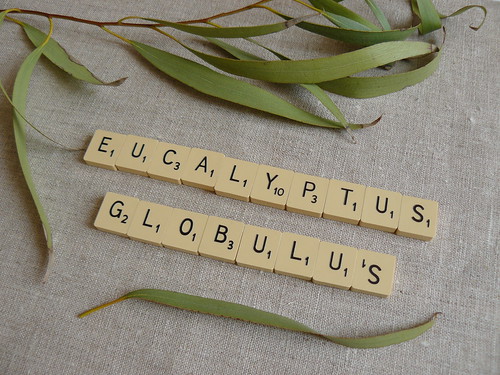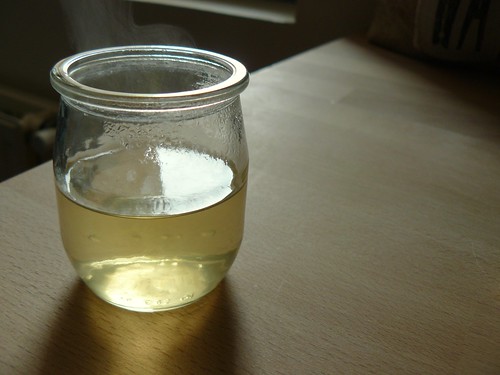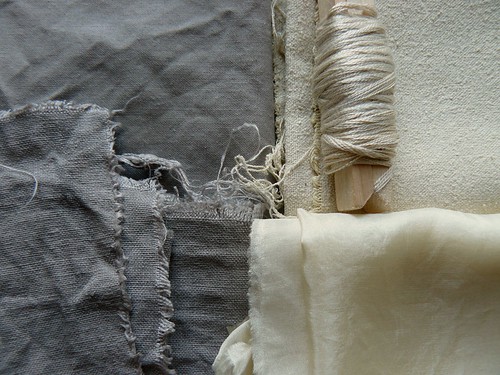e u c a l y p t u s * g l o b u l u s
My parents' neighbours have an Eucalyptus globulus growing in their backyard. Some time ago, as I was telling my mom that I'd love to dye with eucalyptus one day, she told me that her neighbours had one. I was totally amazed, as eucalyptus isn't a very common tree over here, even though in southern France. It's purely ornamental. The leaves aren't blueish at all, they're simply green, but with the slightest hint of blue. After a little research, I found that it was an Eucalyptus globulus.
Blue gum is one of the most extensively planted eucalypts. Its rapid growth and adaptability to a range of conditions is responsible for its popularity. It is especially well-suited to countries with a Mediterranean-type climate, but also grows well in high altitudes in the tropics.
Blue gum timber is yellow-brown, fairly heavy, with an interlocked grain, and is difficult to season. The tree is widely cultivated elsewhere in the world. It is primarily planted as a pulpwood, and also as an important fuelwood in many countries. It has poor lumber qualities due to growth stress problems, but can be used in construction, fence posts and poles.
The leaves are steam distilled to extract eucalyptus oil. E.globulus is the primary source of global eucalyptus oil production.
Blue gum flowers are considered a good source of nectar and pollen for bees.I have decided to dye only silks first, and then to dye a piece of linen & a piece of cotton. Last Wednesday, I decided to dye silks first, as I didn't have to mordant them. I brought water to boil, then added the leaves (at least as much, in weight, as the weight of the fabrics) I let the leaves simmer very lightly for 45mn, then removed them, lowered the heat & added the silks. (a piece of silk bourette, a length of smooth silk & 8 meters of silk yarn) I use an enamel pot for this. The heat was not that strong, as the water must not move, neither the fabrics. I let the silks for another 45mn. Then got out of the fire & let in the enamel pot overnight. Then rinced them & dried them in the shade. This is the color of the dye itself, a light yellow.And this is the result, for the silks I dyed last Sunday.A very light & subtle yellow (or cream-ish yellow) as you can see.
Now ...
I had enough leaves to make another dye. I asked Eva for tips, as she had already dyed with eucalyptus. She referred to a book we have in common, a book I had bought thanks to her, after seeing her eco prints on her Flickr stream. That book is a treasure in itself, not only it is absolutely a delight to look at (each page is so beautiful, I swear) but is so informative, even you don't dye itself. The author is the botanical alchemist, artist & dyer, India Flint. I had bought her book "Eco Colour" a couple of months ago, but life being life, I had a bit, er, forgotten about the book, and anyway I had nothing to dye with. Then, when I had the opportunity to dye with eucalyptus, and after asking Eva, I immediately returned to her book. To my own delight.
 So, after reading that she was advicing to mordant cellulosic fibers (such as the cotton & linen I was planning to dye) with soy. It was easier for me to use soy milk, so that's what I used. I soaked the two pieces in soymilk & let them more than a whole day in it. Then I rinced them & started the same process for making the dye bath with the leaves. Still in the enamel pot. Brought the water to boil, added the leaves, let simmer for 45mn, removed the leaves, added the fabrics & lowered the heat & left for 45mn. Once the time was over, I DIDN'T leave the fabrics in the enamel pot. I decided to use the what-used-to-be-stainless-steel-but-which-apparently-isn't-anymore bucket, and poured the dye bath & the fabrics in that bucket. And left it overnight. What was my surprise to see that the yellow dye bath had turned to ..... dark grey !!! I left them a little bit more, and rinced them yesterday evening & dried them in the shade all night. The final, and dry, result is a slightly brownish grey, which is absolutely delicious ! Look :The cotton is on top left, linen on bottom left, silk bourette on top right (with silk yarn around a wooden clothespin), smooth silk on bottom right.
So, after reading that she was advicing to mordant cellulosic fibers (such as the cotton & linen I was planning to dye) with soy. It was easier for me to use soy milk, so that's what I used. I soaked the two pieces in soymilk & let them more than a whole day in it. Then I rinced them & started the same process for making the dye bath with the leaves. Still in the enamel pot. Brought the water to boil, added the leaves, let simmer for 45mn, removed the leaves, added the fabrics & lowered the heat & left for 45mn. Once the time was over, I DIDN'T leave the fabrics in the enamel pot. I decided to use the what-used-to-be-stainless-steel-but-which-apparently-isn't-anymore bucket, and poured the dye bath & the fabrics in that bucket. And left it overnight. What was my surprise to see that the yellow dye bath had turned to ..... dark grey !!! I left them a little bit more, and rinced them yesterday evening & dried them in the shade all night. The final, and dry, result is a slightly brownish grey, which is absolutely delicious ! Look :The cotton is on top left, linen on bottom left, silk bourette on top right (with silk yarn around a wooden clothespin), smooth silk on bottom right.
What can I add ? Um, yes. As India Flint & Eva pointed, the quality of water does matter. Our water is quite hard, so I added a bit of white vinegar in the water before boiling, to get at least a neutral PH water. Thank goodness I have little scientists at home, and can use PH paper as much as I want !
I am beyond excited with the results, and my mom, who should visit tomorrow, is going to bring more eucalyptus leaves, and I'm sure I'll be dyeing again with them the next few days. She is supposed to bring me an old pot in which I will be able to steam & make eco prints.
I have been a little inspired by the leaves & have painted with watercolors this morning. I hope to show something soon.
Thank you very much for reading, girls :)
e u c a l y p t u s * g l o b u l u s
It is also named Tasmanian Blue Gum, Southern Blue Gum or Blue Gum. It is an evergreen tree, one of the most widely cultivated trees native to Australia. They typically grow from 30 to 55 m (98 to 180 ft) tall.The species name is from the Latin globulus, a little button, referring to the shape of the operculum.Blue gum is one of the most extensively planted eucalypts. Its rapid growth and adaptability to a range of conditions is responsible for its popularity. It is especially well-suited to countries with a Mediterranean-type climate, but also grows well in high altitudes in the tropics.
Blue gum timber is yellow-brown, fairly heavy, with an interlocked grain, and is difficult to season. The tree is widely cultivated elsewhere in the world. It is primarily planted as a pulpwood, and also as an important fuelwood in many countries. It has poor lumber qualities due to growth stress problems, but can be used in construction, fence posts and poles.
The leaves are steam distilled to extract eucalyptus oil. E.globulus is the primary source of global eucalyptus oil production.
Blue gum flowers are considered a good source of nectar and pollen for bees.I have decided to dye only silks first, and then to dye a piece of linen & a piece of cotton. Last Wednesday, I decided to dye silks first, as I didn't have to mordant them. I brought water to boil, then added the leaves (at least as much, in weight, as the weight of the fabrics) I let the leaves simmer very lightly for 45mn, then removed them, lowered the heat & added the silks. (a piece of silk bourette, a length of smooth silk & 8 meters of silk yarn) I use an enamel pot for this. The heat was not that strong, as the water must not move, neither the fabrics. I let the silks for another 45mn. Then got out of the fire & let in the enamel pot overnight. Then rinced them & dried them in the shade. This is the color of the dye itself, a light yellow.And this is the result, for the silks I dyed last Sunday.A very light & subtle yellow (or cream-ish yellow) as you can see.
Now ...
I had enough leaves to make another dye. I asked Eva for tips, as she had already dyed with eucalyptus. She referred to a book we have in common, a book I had bought thanks to her, after seeing her eco prints on her Flickr stream. That book is a treasure in itself, not only it is absolutely a delight to look at (each page is so beautiful, I swear) but is so informative, even you don't dye itself. The author is the botanical alchemist, artist & dyer, India Flint. I had bought her book "Eco Colour" a couple of months ago, but life being life, I had a bit, er, forgotten about the book, and anyway I had nothing to dye with. Then, when I had the opportunity to dye with eucalyptus, and after asking Eva, I immediately returned to her book. To my own delight.
 So, after reading that she was advicing to mordant cellulosic fibers (such as the cotton & linen I was planning to dye) with soy. It was easier for me to use soy milk, so that's what I used. I soaked the two pieces in soymilk & let them more than a whole day in it. Then I rinced them & started the same process for making the dye bath with the leaves. Still in the enamel pot. Brought the water to boil, added the leaves, let simmer for 45mn, removed the leaves, added the fabrics & lowered the heat & left for 45mn. Once the time was over, I DIDN'T leave the fabrics in the enamel pot. I decided to use the what-used-to-be-stainless-steel-but-which-apparently-isn't-anymore bucket, and poured the dye bath & the fabrics in that bucket. And left it overnight. What was my surprise to see that the yellow dye bath had turned to ..... dark grey !!! I left them a little bit more, and rinced them yesterday evening & dried them in the shade all night. The final, and dry, result is a slightly brownish grey, which is absolutely delicious ! Look :The cotton is on top left, linen on bottom left, silk bourette on top right (with silk yarn around a wooden clothespin), smooth silk on bottom right.
So, after reading that she was advicing to mordant cellulosic fibers (such as the cotton & linen I was planning to dye) with soy. It was easier for me to use soy milk, so that's what I used. I soaked the two pieces in soymilk & let them more than a whole day in it. Then I rinced them & started the same process for making the dye bath with the leaves. Still in the enamel pot. Brought the water to boil, added the leaves, let simmer for 45mn, removed the leaves, added the fabrics & lowered the heat & left for 45mn. Once the time was over, I DIDN'T leave the fabrics in the enamel pot. I decided to use the what-used-to-be-stainless-steel-but-which-apparently-isn't-anymore bucket, and poured the dye bath & the fabrics in that bucket. And left it overnight. What was my surprise to see that the yellow dye bath had turned to ..... dark grey !!! I left them a little bit more, and rinced them yesterday evening & dried them in the shade all night. The final, and dry, result is a slightly brownish grey, which is absolutely delicious ! Look :The cotton is on top left, linen on bottom left, silk bourette on top right (with silk yarn around a wooden clothespin), smooth silk on bottom right.What can I add ? Um, yes. As India Flint & Eva pointed, the quality of water does matter. Our water is quite hard, so I added a bit of white vinegar in the water before boiling, to get at least a neutral PH water. Thank goodness I have little scientists at home, and can use PH paper as much as I want !
I am beyond excited with the results, and my mom, who should visit tomorrow, is going to bring more eucalyptus leaves, and I'm sure I'll be dyeing again with them the next few days. She is supposed to bring me an old pot in which I will be able to steam & make eco prints.
I have been a little inspired by the leaves & have painted with watercolors this morning. I hope to show something soon.
Thank you very much for reading, girls :)




this is amazing.. i am in oz and i look at this tree every day .. now that i know it makes this beautiful colour, i will try it out .. thankyou so much for posting this information, and your pictures.. the pictures are lovely, i wonder if the colour would intensify if you dyed it again,,? cannot wait to see your next experiment..
ReplyDeleteThis comment has been removed by a blog administrator.
ReplyDeleteso very addictive isnt it?? love indias book too!!! xx
ReplyDeleteSuch a beautiful colour!
ReplyDeleteI'm new to natural dyeing, and about to embark on some experiments :)
Do you think it was the stainless steel that turned the dyebath to dark grey, or some other part of the process that was different?
Your work is so lovely.
wonderful did do indias course on eco dying , she did not do hand outs and unfortunately we all learn at different speeds so I did not remember much even with help of her book, so thank you very much for your blog and pictures found it much more helpful to be able to see things so clearly written down and phots too marvellous. thank you very much kiwijan
ReplyDeleteThat is a beautiful grey color.
ReplyDeleteI have also tried this, but I only picked the reddish "sun-cooked" leaves from the ground. It gave a lovely golden brown color on linen (I used soy milk and lye(?) in sequence as mordant, as described in India's book).
I just finished a workshop in Melbourne with Pam Hovel eco dying. She is amazing. If you ever want to do a 3 day workshop, make a garment with someone who very generous with her knowledge and dye in in leaves she is so good. My results were amazing. Check out her website.
ReplyDelete